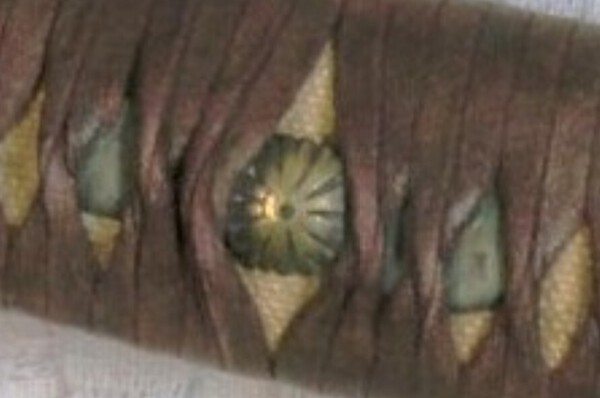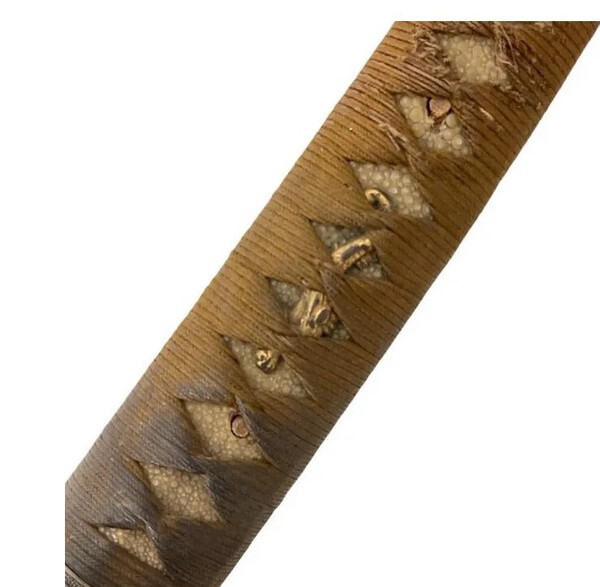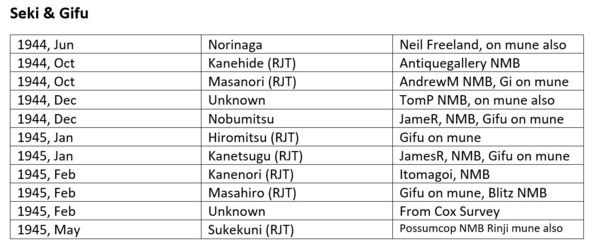-
Posts
13,111 -
Joined
-
Last visited
-
Days Won
157
Content Type
Profiles
Forums
Events
Store
Downloads
Gallery
Everything posted by Bruce Pennington
-
Don't put any weight on my opinion on this, as I'm usually wrong about the smiths, but if that's a Seki stamp at the top, maybe it's this one:
-
Still, yours may be heading more in the right direction. The number of rays, for Japanese police badges, in Dawson's book, are 5, or 8, or, 16 (one odd one with 6). This one seems to have 9. I don't know if the Manchuko govt used police. If so, could this be a Manchukou?
-
I can't find that mon (though I'm not the best at finding them!), but it reminds me of the early Army sun-ray pattern found on a couple of custom kyu, recently. Nick Komiya said the pattern was army, with a large "org" in the center. Smaller orb was for police. Discussed HERE on Warrelics.
-
I'm looking into the mon, too. Chinese fakes don't have mon on the menugi.
-
I've enhanced the last 2 shots. I've short on time today, but I'd like to continue this later. The kabutogane looks legit late-war and the nakago is made much better than what we normally see in fakes. But I's still bothered by that "Made by" stamp. How is the fit with the tsuka (handle) and tsuba/seppa (handguard and spacers) set? Is it tight or loose? Would still like a closeup of the blade tip.
-
Well, I’m pretty sure they were not doing this during World War II. But I could be wrong.
-
Jesse, Thanks for the link. This one is TRYING to look like the ones above, i.e. Army fuchi, but failed badly. Now I don't know what to think about this one. I knew the habaki looked crude, from the beginning. At best, this is something made in China during the war, late in the war. We have been dealing with the topic for some time. Without better pics of the blade and nakago, it's impossible to say if this falls into that group or is just fakery. (pics posted to save for future when auction site is lost)
-
Dale could be right. Is this yours? or pictures from a seller? I'd really like to see clearer pics of the tsuka (handle), close-up of the blade tip, and clear close-ups of the nakago (tang). It has many characteristics of a late-war island-made sword (like the canvas same'). But the gold stamp yells "Chinese fake". Maybe one of the translators can come in on that stamp? The island-made swords don't usually come with the round, plate, tsuba either. At best, an unknown; at worst a fake.
-
Thanks James! That was a good add to the database. So far, all blades triple-marked - 2 on nakago 1 on mune - are in the 1944-45 date range, and almost all are made by RJT smiths. Your Nagamitsu and Niel's Norinaga aren't listed on the Japaneseswordindex RJT page, but they could have missed their source data somehow. No star, so probably not traditionally made.
-
Mark, I assume you've gotten the smith name already, but just in case, I make it to be: 兼清 (Kanekiyo) Also - no date on the other side? If not, it is most likely 1940-41, though could be earlier or later, but the massive majority of Showa stamped blades are '40-'41. To call it a shingunto would be appropriate. It simply means "New Gunto" (gunto - army sword). By the showa stamp, we know it's "New" and by the leather cover, we know it was brought, or sold, or donated to the army for the war. So, it was a new, army sword! B.E.A.Utiful blade, by the way!
-
Don't want to duplicate a thread, but I thought I'd let guys know (that may not prowl all the forums) about the STAMPED NUMBERS ON HABAKI thread on the "Tosogu" forum. It's an old thread I've resurrected. Since it was already on Tosogu, I left it there, rather than asking to transfer it to Military. I'm open to suggestion on that, as I doubt there are stamped numbers on civil habaki.
- 1 reply
-
- 1
-

-
A new one thanks to Infinite_Wisdumb:
-

Is this sword authentic?
Bruce Pennington replied to John Cobra's topic in Auctions and Online Sales or Sellers
Yes, for sure bad fake. -

Emergency Late War Officer Gunto
Bruce Pennington replied to Bruce Pennington's topic in Military Swords of Japan
That's a good link, as George Trotter commented that the quality of the fittings look good and the blade too (for a gunto). So, fairly confirms it wasn't a Chinese made emergency sword. -

Emergency Late War Officer Gunto
Bruce Pennington replied to Bruce Pennington's topic in Military Swords of Japan
Probably right. Stegel probably included this in his post thinking it was one of the Emergency stamped blades, but it's not, as we can see now. Glad we were able to toss it around, though. Got another stamp for the Stamps Doc with a "possible" shop name! Thanks Trystan! -

Emergency Late War Officer Gunto
Bruce Pennington replied to Bruce Pennington's topic in Military Swords of Japan
Welllllllll ..... that conflicts with the idea of these being made in China, UNLESS, like Nick pointed out, they moved their operations to China due to the bombing. -

Emergency Late War Officer Gunto
Bruce Pennington replied to Bruce Pennington's topic in Military Swords of Japan
Thanks Trystan! Unless anyone has something better, I’d put that in the “possibly” to “likely” range. Do you know where they were located? -

Emergency Late War Officer Gunto
Bruce Pennington replied to Bruce Pennington's topic in Military Swords of Japan
Never seen it before, I was hoping YOU knew! -
They all look too shiny. I suppose Generals' dress swords saw a pretty pampered life, but still .... Without your comments, I wouldn't have suspected anything, though. I have don't have enough experience with these to see what you can see.
-

Katana Mei Translation Help Needed Please
Bruce Pennington replied to hddennis's topic in Translation Assistance
So, for the rookies - 1945 -
James, that's fabulous, thanks! Boy the Seki stamp on both these really busted me for a few minutes until I could see what they were. Both are stamped side-ways, and roughly struck. Both are Gifu & Seki plus Gifu on the mune. Can I get mei and date pics for the Kanetsuga? Also, the Nobumitsu has 2 mekugi ana ... so Rinji fittings? How about the Kanetsuga? Again, thanks for the help!
-

Emergency Late War Officer Gunto
Bruce Pennington replied to Bruce Pennington's topic in Military Swords of Japan
I would be interested to hear from people that on these concerning that question too. I have one that I thought was a Chinese fake, but after reading this it might be what you were talking about. I don’t have it in hand right now, but when I can get to it I will take some photographs and post it. -
He doesn't say. All these began in the late 1800s with Japan's move to western styled weapons. Nick Komiya, at warrelics, has discussed some army models that were revised in 1914, but I haven't seen a rundown on dates for police swords and dirks.
-
The belt loop (haikan) is missing, but for that, identical to the example in Fuller & Gregory, page 191. Police dirk, speculating that it is for a Sergeant, due to lack of floral design on backstrap.
-
So, it sounds like the same manufacturing operation, changing names as it changes hands? In any case, my pursuit of the OP stamp is still unresolved. As of now, I like my comparison of the Toyokawa stamp being different on blades than it is on fittings.










